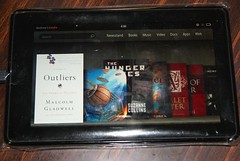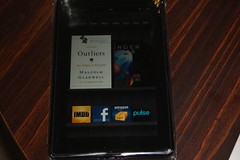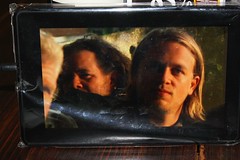Price: $10 +/- stick
Wrapper: Cameroon
Binder: Indonesian
Filler: Dominican grown Cubano Piloto
Aged in Humidor: One Month
Appearance and Construction:
The Cohiba Red Dot in a Robusto size seems tiny, but sometimes I don't like fat and long ones because I don't like going over an hour smoking, no matter how good. Pleasure only last so long before it becomes ordinary. The wrapper appears to be a nice dark shade of brown. The cap and body are clean and smooth looking. The end of the cigar where you light it does not have a perfect filled oval layer of filler, there are three tiny nooks. There is also a white string like stem from a tobacco leaf amongst all the brown layers but I have seen this in other cigar endings, no biggie this may be just the stick I am smoking. It has a slightly oily shine to it. To me, it looks like someone took a stick of wood emptied it out, sanded it out to a uniform cylinder, filled it with tobacco filler, put a dark polish on it and lightly lacquered it. The cigar is firm and bounces back ever so slightly on squeezing the body. This appears to be a well built stick. Even the band is designed smoothly and stays on there well, it moves only ever so slightly.
Tasting Notes:
On prelighting I get only a tad aroma of that sweet and earthy smell. I do this four times because I like the scent of a cigar as much as the smoking part. Each time I only get a light aroma, possibly because it has been sitting in my humidor only a month.
I light it up. In my opinion of the one I smoked, this is a mild to medium flavored cigar. The Cohiba Red Dot would be nice for an average day relaxing or lounging. The price range for these are for ten dollars, I think not worthy, maybe for a lower price. On initial light it starts off soft burning with light smoke. I easily detect tiny hints of spice and sweet earthy flavors. The mediocre tobacco flavor is there, sometimes just that, tobacco flavor, no sweet or complex flavors. It burns slowly with that light spice and sweet earthiness appearing and disappearing.
At the second of third stage is when it becomes slightly interesting and the flavor of sweet cinnamon on woodiness comes into play. This is when it becomes good. At this point I can see that this Cohiba Red Dot is nicely rolled because it is still burning at a very tranquil pace, the ash reaches the one inch phase and drops off, but it was like a white and grey tater tot with parts of it's shell lightly flaking off. It comes and goes, that hint of sweet cinnamon on wood flavor. I can also detect a nutty flavor, like hazelnut or almond. I would say this is the nicest part of the cigar and I float down stream with this aroma until the third stage where it's just mostly tobacco flavors and a hint of coffee. I smoke it all the way to the nub as I do often. The before and the aftermath smell of the cigar are good: a lightly sweetened earthy aroma.
I would rate this a 85 because I sure had worst and far better. This is a good kind of mild cigar. Maybe another in the future or a XV
Photo of the Cohiba Red Dot Robusto against a background chilies in my yard
Comparison:
I can only slightly try and compare the original Cuban Cohiba to the Dominican Cubano Cohiba Red Dot. I tried to detect similar flavors that came from one to see if the same flavors were on the other but the similarities in flavor and construction were only so slightly present. Why? Because besides the name, I believe that's where it ends. They are two totally different brands, two totally different companies and totally different in growth and manufacturing. I have to say the Cohiba Esplendido cigars were of course much better than the Cohiba Red Dot cigars. I don't think the size had anything to do with it because the Esplendido is a Julieta No. 2 (Churchill) sized cigar and the Red Dot was a Robusto. Regardless of the size, say if the Red Dot had been a Churchill size, I think it would have been the same outcome. I think the darker wrapper of the Red Dot cigar versus the lighter tan of the Habanos S.A. cigar had a low significance on how the cigar smoked and how tasty it was or will be. If you look at the photos below, both have similar appearances.
The love affair of the Cuban Habanos S.A. brand comes from the flavor and a bit of how it smokes, in my opinion. Could it be due to the hype of an awesome object far away forbidden and harder to get because of the embargo, yes, that too. But then again other countries don't have this embargo with Cuba, it's just the U.S., so no, it's not hype. If you smoked one and then the other, you can then experience for yourself the complexity and how it smokes (draw, burn, ash, aroma...) differs quite a bit from one to the other.
You take the Cuban version, I assume like most people, all it's parts (filler, wrapper, binder, cap) are from Cuba and made (original seeding, harvesting, fermenting, blending and rolled) in Cuba by Cubans. Meaning usually but not always a product made by it's original people and crafted in the culture it originated from will have it's heritage and refinement through the years. Thus, even though cigar smokers want that product, the access to the product is not there due to the embargo or limitation. To meet that desire, they created Cohiba Red Dot, baring the same name and attempted to be crafted or marketed to be just like the Cuban version. Even with part of the filler with the Cubano seed, you're not getting the same thing. The parts come from the Dominican Republic, Africa, Indonesia... It's not the exact seeding, aging, blending or rolling. Due to legality of branding, it's just the same name, not the same product, no matter how much the attempt or marketing.




